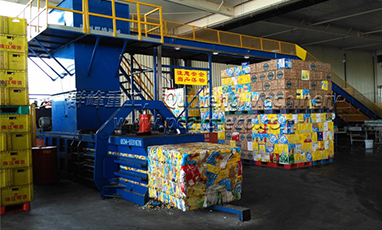Thehydraulic baler machine can squeeze all kinds of metal scraps (steel shavings, scrap steel, scrap aluminum, scrap copper, scrap stainless steel, scrap car scrap, etc.) into various shapes such as cuboid, octagon, cylinder, etc. The charge can reduce the transportation and smelting cost, and increase the furnace putting speed.
Hydraulic baling machine is mainly used in steel mills, crop straw, recycling and processing industries, and non-ferrous and ferrous metal smelting industries.
●The composition of hydraulic baler●
The structure of the hydraulic baler includes the mainframe system, auxiliary components, and a hydraulic system. The mainframe system is made of a high-quality thick steel plate, which is more durable; the hydraulic system is composed of hydraulic pumps, hydraulic cylinder oil, and other parts; the main structure of the electronic control system generally includes travel switches, buttons, etc.
●Precautions for hydraulic baler●
When using the machine, in order to ensure the durability of its use, it is necessary to carry out regular maintenance and maintenance. In the process of use, it is also necessary to avoid errors and improper operations to damage the machine. The following items should be paid attention to when using hydraulic baler:
1. The hydraulic oil added to the oil tank should use high-quality anti-wear hydraulic oil. This oil must also go through a strict filtering process. It should also maintain a sufficient amount of oil. When the amount of oil is insufficient, add it in time to avoid damage to the machine.
2. The fuel tank needs to be cleaned regularly and replaced with new oil, usually every six months. However, the first cleaning time should not exceed one month, and the used new oil can be used again after filtering.

Hydraulic Baler Machine
3. The lubrication part of the machine should use high-grade lubricating oil and add lubricating oil at least once per shift.
4. If there is debris in the bin, clean up in time to avoid the accumulation of debris on the bin and even the operation of the entire machine.
5. The operator of the machine should have a certain degree of understanding of the machine as much as possible. Those who do not understand the structure of the machine are strictly prohibited from approaching the machine, and those who do not understand the structure, performance and operating conditions of the machine are strictly prohibited from operating the machine without authorization.
6. When the machine is found to be seriously damaged or oil leaking, it should stop running immediately, and analyze the cause and failure, and not force it to run.
7. When the machine is running, it should not be repaired or touched to avoid accidental injury.
8. When pumps, valves, and pressure gauges are adjusted, they must be inspected by experienced workers.
9. The operator should be clear about the use and maintenance of the machine, as well as related safety awareness.